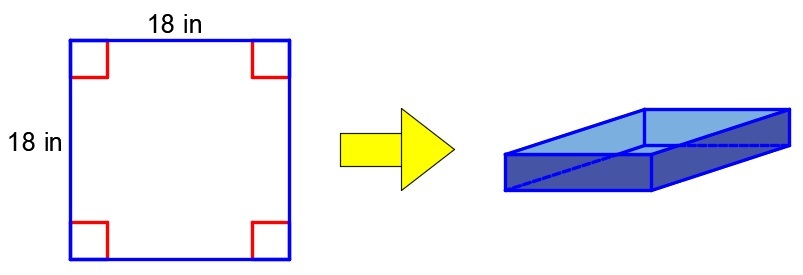Largest container box
A container box open on top is to be made from (18 inches) x (18 inches) galvanized flat sheet metal by cutting equal squares out of the corners and turning up the sides.
Find the largest box (in cubic inches) that can be made in this way.

Note: Neglect the thickness of the galvanized flat sheet metal.
The answer is 432.
This section requires Javascript.
You are seeing this because something didn't load right. We suggest you, (a) try
refreshing the page, (b) enabling javascript if it is disabled on your browser and,
finally, (c)
loading the
non-javascript version of this page
. We're sorry about the hassle.
d x d v = 3 2 4 − 1 4 4 x + 1 2 x 2
The first derivative must be equal to zero. We have
d x d v = 0
1 2 x 2 − 1 4 4 x + 3 2 4 = 0
x 2 − 1 2 x + 2 7 = 0
Solve for x by using the quadratic formula. We have
x = 2 1 2 ± 1 4 4 − 4 ( 2 7 )
x = 6 ± 3
The values of x are:
x = 6 + 3 = 9
and
x = 6 − 3 = 3
x = 9 can not be used because 1 8 − 2 x = 0 , so we used x = 3 .
So the desired volume is v = 3 [ 1 8 − 2 ( 3 ) ] 2 = 4 3 2 c u b i c i n c h e s
Second Derivative Test:
d x 2 d 2 v = − 1 4 4 + 2 4 x
when x = 3
d x 2 d 2 v = − 1 4 4 + 2 4 ( 3 ) = − 7 2
− 7 2 < 0 , therefore, v = 4 3 2 c u b i c i n c h e s is a maximum.